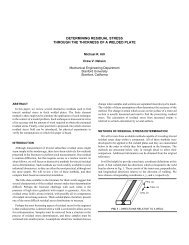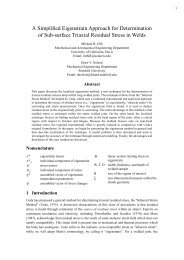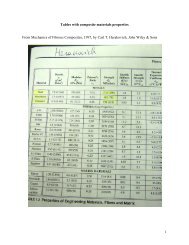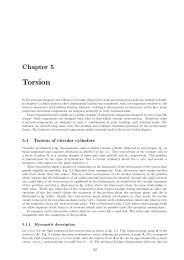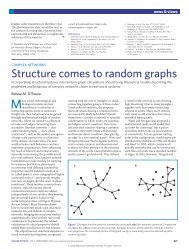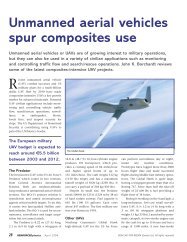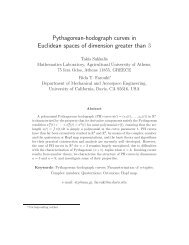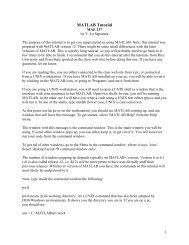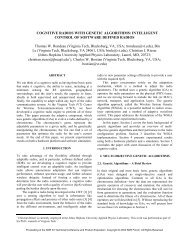Lab 6
Lab 6
Lab 6
Create successful ePaper yourself
Turn your PDF publications into a flip-book with our unique Google optimized e-Paper software.
Equations<br />
We start with two equations, one electrical and the other mechanical. Summing the loop voltages<br />
gives:<br />
dia<br />
(t)<br />
(1) La + R ai<br />
a (t) = ea<br />
(t) − eb<br />
(t)<br />
dt<br />
Summing the torques present at the motor’s output shaft gives<br />
(2) J ω&<br />
(t) + bω(<br />
t)<br />
= T(t)<br />
Equations (1) and (2) are two first-order ODE’s. They are related by the motor’s torque-current<br />
relationship and by the back-emf produced by the motor rotation:<br />
(3) T(t) = kmia(t)<br />
(4) eb(t) = kmω(t)<br />
Note that the same constant (km) appears in both equations (3) and (4). This is only true if we use<br />
SI units. Two constants (called the motor torque constant and the back-emf (electromotive force)<br />
coefficient) are required when English units are used.<br />
The motor’s time response has two time constants (τ) – we’ll call these an electrical and a<br />
mechanical time constant. The electrical time constant is almost always a lot faster than the<br />
mechanical time constant, and is often neglected in modeling the motor dynamics. This is called a<br />
dominant-pole approximation, and is a useful approach to simplifying the model.<br />
To test this assumption, the electrical time constant can be measured by locking the motor shaft in<br />
place. Then eb = kmω(t) = 0, and equation (1) simplifies to:<br />
dia<br />
(t)<br />
(5) La + R ai<br />
a (t) = ea<br />
(t)<br />
dt<br />
If we apply a voltage step to the motor (ea(t) = ea for t > 0), we expect to see an exponential<br />
La<br />
ea<br />
response with a time constant given by τ = and a steady-state current of i ss = . We can<br />
R a<br />
R a<br />
use measurements of τ and iss to determine Ra and La.<br />
When the motor shaft is unlocked, we can use steady-state measurements of the input current,<br />
motor speed, and applied voltage to determine the torque constant (km) and the viscous damping<br />
coefficient (b). In steady-state, all the derivative terms in equations (1) and (2) are zero, so we<br />
have:<br />
(6) k mωss<br />
= ea<br />
− R ai<br />
a, ss<br />
k mi<br />
a, ss<br />
(7) ωss<br />
=<br />
b<br />
The final parameter to be measured is the motor’s moment of inertia, J. If the electrical time<br />
constant is very fast, the dynamic model for the motor is simplified by neglecting the first term in<br />
equation (1):<br />
(8) i (t) =<br />
e (t) − e (t)<br />
R a a a b<br />
8





